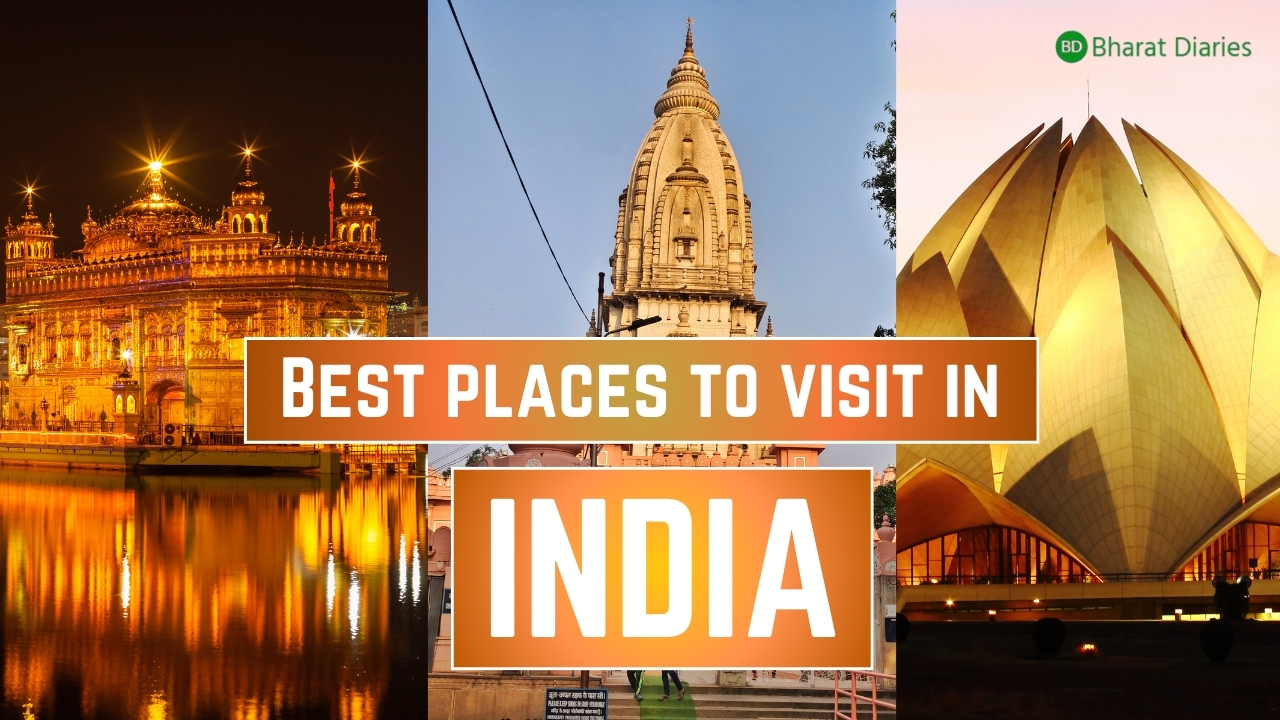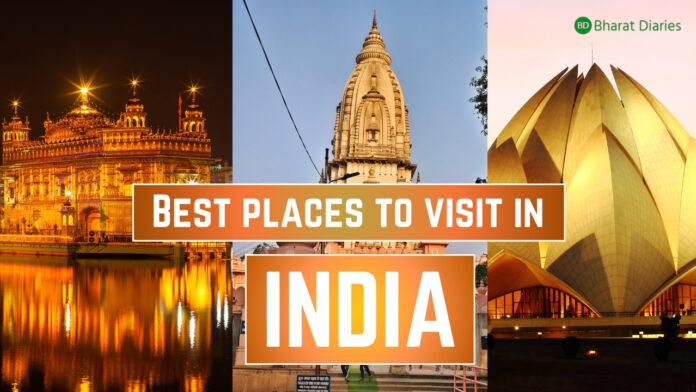
Discover the best destinations for Tourism for Foreigners in India during September 2025. Explore temples, culture, and history with a safe 8-city travel itinerary.
Table of Contents
India is more than just a country — it is an experience. From the bustling streets of Delhi to the calm ghats of Varanasi, from the architectural brilliance of Agra to the spiritual silence of Rishikesh, every corner tells a story. For foreigners, visiting India is not only about sightseeing but about immersing in a way of life that has continued for thousands of years.
September is a particularly good month for international tourists to explore India. The heavy monsoon rains are fading, the weather is cooler, and major festivals like Ganesh Chaturthi and Onam create a vibrant atmosphere. Hotels and flights are still reasonably priced compared to the peak winter tourist season.
⚠️ Important Note: Tourism for Foreigners in India
While September is ideal for cultural and historical tours, it is not recommended to visit hill stations such as Shimla, Manali, Mussoorie, or Darjeeling due to frequent landslides in monsoon-affected areas. Instead, the safest and most enriching journey lies in exploring the plains — where India’s temples, forts, and spiritual hubs showcase the best of Indian heritage.
This blog provides a step-by-step 12-day itinerary designed especially for foreign travelers landing in Delhi from countries like the US, UK, Russia, or any European nation. The itinerary connects 8 must-visit destinations in one smooth road-and-flight string.
The Travel String (Delhi Round Trip)
✈️ Arrival in Delhi →
🚗 Delhi sightseeing →
🚗 Agra →
🚗 Jaipur →
✈️ Varanasi →
🚗 Bodh Gaya →
✈️ Khajuraho →
🚗 Delhi → Rishikesh →
✈️ Amritsar →
✈️ Back to Delhi → Departure.
This string ensures:
- No backtracking.
- Mix of history, culture, and spirituality.
- Smooth transfers via expressways and short flights.
- Safe destinations during September.
Day-Wise Detailed Itinerary
Day 1–2: Delhi – Gateway to India
Delhi, the capital of India, is often the first stop for foreign travelers. It is a city where the old and the new coexist. You’ll find Mughal-era forts standing tall beside modern shopping malls, centuries-old bazaars next to glass office towers, and sacred temples hidden between crowded streets.
Key Attractions:
- Red Fort: A UNESCO World Heritage site built by Mughal emperor Shah Jahan. Its red sandstone walls have witnessed the rise and fall of empires. Don’t miss the evening light and sound show that narrates Delhi’s history.
- India Gate: A war memorial dedicated to Indian soldiers of World War I. It is beautifully lit up at night and a great place for evening strolls.
- Lotus Temple: A Bahá’í House of Worship known for its lotus-shaped architecture. Open to all faiths, it’s a place of meditation and peace.
- Akshardham Temple: A modern marvel, showcasing intricate carvings and a cultural boat ride that narrates 10,000 years of Indian history.
- Qutub Minar: The tallest brick minaret in the world, dating back to the 12th century. Its carvings are a testimony to Indo-Islamic architecture.
- Chandni Chowk: One of the oldest markets in India. Try parathas at the Paranthe Wali Gali and shop for spices, jewelry, and handicrafts.
Tips for Foreigners:
- Use Delhi Metro or pre-booked cabs (Ola/Uber) to avoid scams.
- Dress modestly for temples.
- Stay near Connaught Place or Aerocity for good hotels and connectivity.
Day 3: Agra – The City of the Taj Mahal
Travel from Delhi to Agra via the Yamuna Expressway (3.5–4 hours). Agra, once the capital of the Mughal Empire, is home to some of the most beautiful monuments in the world.
Key Attractions:
- Taj Mahal: A UNESCO site and one of the Seven Wonders of the World. Built by Shah Jahan in memory of his wife Mumtaz Mahal, it is best visited at sunrise when the marble glows golden. The reflection of the Taj in the Yamuna river is breathtaking.
- Agra Fort: A massive red sandstone fort that was once the main residence of the Mughal emperors. Explore its palaces, mosques, and audience halls.
- Mehtab Bagh: A garden complex across the river offering the best sunset view of the Taj Mahal.
Food to Try:
- Agra Petha (a sweet made of ash gourd).
- Mughlai dishes like kebabs and biryani.
Day 4–5: Jaipur – Royal Rajasthan
From Agra, travel to Jaipur (4.5 hours via NH21). Known as the Pink City, Jaipur offers a royal experience with forts, palaces, and colorful bazaars.
Key Attractions:
- Amber Fort: Famous for its artistic Hindu–Mughal architecture. The Sheesh Mahal (Mirror Palace) inside glitters with tiny mirror work.
- Hawa Mahal (Palace of Winds): With 953 windows, this pink sandstone palace allowed royal women to observe street processions.
- City Palace: The residence of the Jaipur royal family. It includes museums showcasing royal costumes and weapons.
- Jantar Mantar: An astronomical observatory built by King Jai Singh II, still accurate in predicting celestial events.
Evening Experience:
- Visit Chokhi Dhani, an ethnic village resort that serves Rajasthani cuisine and showcases folk dance and puppet shows.
Day 6–7: Varanasi – The Spiritual Heart of India
Take a short flight from Jaipur to Varanasi (2 hours). Varanasi, also called Kashi, is the world’s oldest continuously inhabited city and the spiritual capital of Hinduism.
Key Attractions:
- Ganga Aarti at Dashashwamedh Ghat: Every evening, priests perform a grand fire ritual with chants, bells, and lamps. It’s a once-in-a-lifetime experience.
- Sunrise Boat Ride: Witness the ghats coming alive as locals bathe, pray, and wash clothes. The golden sunrise over the Ganga is unforgettable.
- Kashi Vishwanath Temple: One of the twelve Jyotirlingas dedicated to Lord Shiva. Security is tight, but the spiritual energy is unmatched.
- Sarnath: Just outside Varanasi, this is where Lord Buddha gave his first sermon. The Dhamek Stupa and museum are must-sees.
Tips:
- The lanes are narrow; walking or cycle-rickshaws are the best options.
- Carry small notes for donations at temples/ghats.
Day 8: Bodh Gaya – Where Buddha Attained Enlightenment
Travel by road from Varanasi to Bodh Gaya (5.5 hours). This is one of the most sacred places for Buddhists worldwide.
Key Attractions:
- Mahabodhi Temple: A UNESCO site, marking the exact spot where Buddha attained enlightenment under the Bodhi Tree.
- Bodhi Tree: Pilgrims from across the world meditate here.
- Great Buddha Statue: An 80-foot-tall statue symbolizing peace and compassion.
- International Monasteries: Explore Thai, Japanese, and Tibetan monasteries built around the temple complex.
Day 9: Khajuraho – Temples of Art and Sculpture
Take a short flight from Bodh Gaya to Khajuraho (1.5 hours). Famous for its intricate temples, Khajuraho is a UNESCO site known for its Nagara-style architecture.
Key Attractions:
- Kandariya Mahadeva Temple: The largest and most ornate temple, dedicated to Lord Shiva.
- Western Group of Temples: Famous for their sculptures depicting daily life, love, and spirituality.
- Light & Sound Show: Narrates the history of Khajuraho temples at night.
Cultural Note:
Foreign visitors often misunderstand the erotic sculptures. They represent the philosophy that spirituality and worldly life are interconnected.
Day 10: Rishikesh – Yoga Capital of the World
Fly back to Delhi and drive to Rishikesh (5–6 hours). Nestled on the banks of the Ganga, Rishikesh is not only the yoga capital of the world but also a spiritual retreat.
Key Attractions:
- Parmarth Niketan Ashram: Attend yoga sessions and evening Ganga Aarti.
- Lakshman Jhula & Ram Jhula: Iconic suspension bridges across the river.
- Triveni Ghat: A peaceful spot for meditation.
⚠️ Warning: Avoid trekking and hill routes around Rishikesh in September due to landslides. Focus on riverbank activities and yoga retreats.
Day 11–12: Amritsar – The Soul of Punjab
Fly from Delhi to Amritsar (1 hour). This city is the spiritual home of Sikhism and also a place where modern Indian history comes alive.
Key Attractions:
- Golden Temple (Harmandir Sahib): The holiest shrine of Sikhism, open to all. Don’t miss langar (community meal) which serves thousands daily.
- Wagah Border Ceremony: Witness the patriotic energy at the India–Pakistan border where soldiers perform a coordinated parade.
- Partition Museum: Learn about the 1947 Partition and stories of refugees.
Food to Try:
- Amritsari Kulcha (stuffed bread).
- Lassi (sweet yogurt drink).
Conclusion
For foreigners visiting India in September 2025, this itinerary offers the best mix of history, culture, spirituality, and safety. Starting from Delhi and covering Agra, Jaipur, Varanasi, Bodh Gaya, Khajuraho, Rishikesh, and Amritsar, it creates a complete picture of India — one that is unforgettable.
India is not just about monuments and temples; it is about experiences. Watching the sun rise over the Taj Mahal, sitting silently under the Bodhi Tree, chanting during Ganga Aarti, or sharing a meal at the Golden Temple — these are the moments that make a trip to India memorable.
⚠️ Final Travel Note: Avoid hill regions in September due to landslide risks. Stick to this carefully designed plain-route itinerary for a safe and enriching journey.
